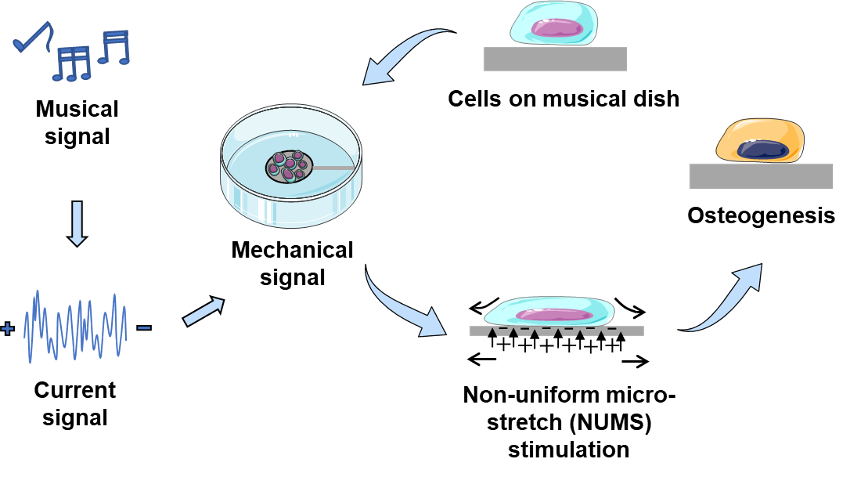Stretch, as a form of mechanical force, plays a crucial role in regulating cell behaviors, preventing injuries and repairing tissues such as lung, heart, brain and skeletal system. Among them, stretch in bone tissues has captured the most immense attention in clinical applications, for bone tissues are continuously exposed to stretch stimulation during physiological activities. The structure and function of bone tissues relies on a proper amount of stretch stimulation, while lack of exercises tends to result in the reduction of bone volume and osteoporosis. Under physiological conditions, bone tissues are subjected to micro-stretch with a variable frequency.
Although there has been a massive body of research into the effects of stretch stimulation with a constant frequency, the biological effects of micro-stretch with a variable frequency have not yet been identified. Moreover, commercial stretching devices are unable to generate stretch with a variable frequency similar to the in vivo condition of bone tissues. Against this backdrop, the research team led by Prof. OUYANG Hongwei proposed a novel cell stretcher, named as “musical dish”, which for the first time used the conversion of musical signals to mechanical signals to realize the regulation of stem cell fate by micro-stretch with a variable frequency (NUMS). Their research findings were published in Bioengineering & Translational Medicine, entitled “’Musical dish’ efficiently induces osteogenic differentiation of mesenchymal stem cells through music derived micro-stretch with variable frequency”.
In this study, the researchers developed a musical dish with fast response, large deformation, optical transparency and robust controllability, based on dielectric elastomer actuators (DEAs) . This musical dish could convert musical signals into electrical ones, which could further converted into mechanical energy via a flexible dielectric elastomer membrane. It could trigger stretching stably. The actuating strain was featured by homogeneity and equiaxiality. When cells were seeded on the musical dish, they could proliferate normally. The cells showed displacement with the increase of the voltage. To evaluate the effect of NUMS, 1 kV constant voltage with musical signals was applied to cells. The stretch ranged from 0.833% to 0.867% which is close to the stretch condition in bone tissues. Quantitative analysis revealed that cells in the NUMS group exhibited more marked filamentous stress fibers than constant stretch and no stretch groups. Bone development and ossification were up-regulated according to the gene ontology (GO) enrichment analysis. Further, Experiments identified a significant increase in the expression of bone cell-related genes under NUMS, but the expression of stemness-related genes decreased tremendously. The NUMS also promoted osteogenic differentiation of cells in induction medium.
These findings highlight a novel “musical dish,” which allows arbitrary strain waveforms to be applied to cells by converting music signals into the stretching force. In comparison with constant stretching, NUMS may have great potential for promoting bone differentiation of cells. For clinical applications, three strategies may contribute to the development of potential therapeutic ways for bone regeneration. First, NUMS could be used in the distraction osteogenesis surgery to replace or assist the current large-scale and slow stretching method for bone regeneration due to its superb performance in promoting osteogenic differentiation. Second, the musical dish could be further developed into a music-derived rehabilitation technology to promote bone healing. Finally, the musical dish could serve as a cell expansion bioreactor to produce cells with a high level of osteogenic differentiation to repair bones by transplantation. Thus, both the new stretching model and the newly-developed stretching device may have a brilliant clinical prospect.








